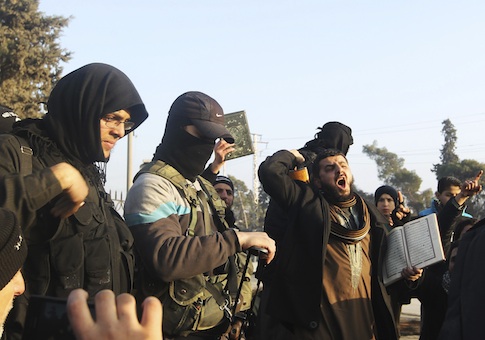American adversaries in the Middle East continue to work together across sectarian and religious divides to harm U.S. interests and security, requiring a more nuanced response from U.S. officials to address the turmoil in the region, experts say.
The Obama administration has claimed in recent weeks that the United States and Iran—a traditional U.S. enemy since its Islamic revolution 35 years ago—have a shared interest in pushing back the advances of the Islamic State of Iraq and the Levant (ISIL or ISIS), an al Qaeda offshoot, in Iraq. Defense Secretary Chuck Hagel said last month that the United States and Iran have "some history here of sharing common interests," citing early cooperation on the Afghanistan war against al Qaeda and the Taliban.
Iran, led by a Shiite government, is typically viewed as opposing hardline Sunni groups such as the Taliban and al Qaeda as part of an intra-religious dispute among Muslims.
However, Iran has a long history of harboring and supporting al Qaeda. European intelligence reports indicate that Abu Musab al-Zarqawi, founder of the group al Qaeda in Iraq (AQI) that eventually morphed into ISIL, operated from Iran after the U.S. invasion of Afghanistan in 2001. Zarqawi used protection from the Iranian Revolutionary Guard Corps (IRGC) to rebuild the terrorist group’s network and prepare for its expansion into Iraq.
The U.S. Treasury Department has called Iran "a critical transit point for funding to support al Qaeda’s activities in Afghanistan and Pakistan." The department in February sanctioned three IRGC officers for allegedly providing support to the Taliban as well as to a senior member of al Qaeda who allegedly used Iran to move Sunni fighters into Syria.
"Iran has a long history of fomenting violent conflict and inflaming sectarian divides throughout the Middle East including in Lebanon, Syria and Iraq," said the group United Against Nuclear Iran (UANI) in recent press release.
"Depictions of Iran as a source of stability are therefore erroneous and short-sighted, as are assertions that increased Iranian involvement in Iraq will serve American and Iraqi interests," UANI added.
Michael Rubin, resident scholar at the American Enterprise Institute (AEI) and a former Pentagon adviser on Iran and Iraq for the George W. Bush administration, said in an email that U.S. diplomats often only view the Middle East through "a sectarian lens."
"Sunnis and Shi’ites show no compunction working together to screw over America, which their respective extremists consider a bigger threat," he said. "Heck, sometimes it seems that the State Department never bothered to read the 9/11 report which suggested that the attacks might not have happened had Iran not facilitated the travel to training camps of the 9/11 hijackers."
"Sure, at first glance, Secretary of State John Kerry may believe that the U.S. and Iran share an interest in Iraq," he added. "But just because firefighters and arsonists share an interest in fire doesn’t mean they are on the same side."
In Iraq, ISIL partnered last month with former Baathist generals under Saddam Hussein’s regime to seize the key northern city of Mosul. Religious extremist groups such as al Qaeda have traditionally sought to overthrow secular Middle East regimes such as Hussein’s Baathists.
Top U.S. officials have recently expressed grave concerns about the potential for foreign fighters in ISIL to commit terrorist attacks in the United States.
The secular-religious rift in the Middle East also did not stop Hussein from supporting jihadist groups when it suited the former Iraqi dictator’s interests. Hussein reportedly provided safe haven, training, and arms to these groups as long as they agreed to attack countries he wanted to pressure.
Hundreds of thousands of documents obtained in Iraq since 2003, compiled in a report by the Institute for Defense Analyses, further confirmed Hussein’s links to terrorist groups.
"Saddam supported groups that either associated directly with al Qaeda (such as the Egyptian Islamic Jihad, led at one time by bin Laden's deputy, Ayman al-Zawahiri) or that generally shared al Qaeda's stated goals and objectives," the report said.
Additionally, Syrian President Bashar al-Assad—a member of the Alawites, a minority Shiite sect—has reportedly formed a tacit alliance with the extremist Sunni fighters in ISIL to bring about the collapse of moderate rebels battling his government.
The New York Times reported earlier this year that ISIL began selling fuel directly to the Assad regime after seizing the oil-rich northern province of Raqqa. Assad’s forces largely avoid attacking ISIL’s stronghold in northern and eastern Syria as both groups of fighters work to eliminate the moderate opposition.
Assad pledged this week after his reelection—dismissed as a sham by his opponents—that he would "not stop fighting terrorism," despite his regime’s partnership with ISIL.
Although President Obama called on Assad to "step aside" in 2011, his administration has provided scant assistance to the beleaguered moderate rebels fighting both the regime and ISIL.
Rubin, the AEI scholar, said U.S. officials must craft a new strategy for the Middle East that goes beyond seeing "grievance as the root of terrorism."
"The real threat in the region is ideological," he said. "Islamist extremism cuts across sects, and should be countered and defeated whether it is Iranian-sponsored Shi‘ite extremism or Qatari, Saudi, or Turkish-sponsored Sunni extremism."
